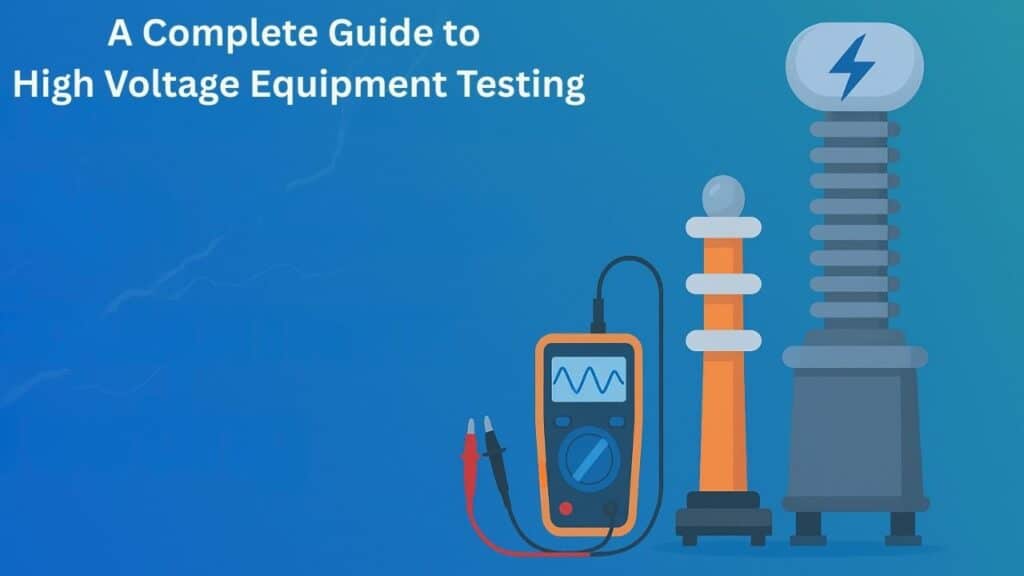- Home
- About Us
- Blog
- Services
- Equipment
- Online Testing
- Offline Testing
- Partial-Discharge
- CPC 100 Multifuncational Switchyard
- Vlf Tan Delta Measurement
- Current Signature Analysis
- Relay Measurement
- CT Measurement
- SFRA Measurement
- Moisture Analysis by PDS & PDC
- Turns-Ratio-Measurement
- Winding Resistance Measurement
- OLTC-DCRM-Measurements
- Frequency Response stray Losses
- Circuit Breaker Analyzer & DCRM Test
- Circuit Breaker Timer
- Contact Resistance Meters
- Particle Count Tester-Pamas
- TRAX Multifunctional switchyard Diagnostic Test
- TESTRANO-600
- Surge Tester-jabbals
- Circuit Breaker Analyzer
- Gallery
- Careers
- Contact Us
A Complete Guide to High Voltage Equipment Testing

Today, as electricity keeps our homes and businesses running, making electrical systems reliable and safe is necessary. The high voltage equipment testing is vital to this work because it helps to protect the performance and durability of all equipment used in electrical infrastructure.
No matter if you operate a power plant, a factory, or a high-voltage grid, it is vital to understand how diagnostics work to prevent significant delays, provide safety, and comply with industry requirements.
With helpful guidance provided by Lax Energy Solutions Pvt Ltd , this guide enables you to understand and perform high-voltage (HV) diagnostics without difficulty.
What is High-voltage equipment testing?
Testing equipment using high voltage in electrical engineering guarantees that power system items like transformers, circuit breakers, insulators, and cables are both safe and efficient.
For equipment working at such high-voltage levels as those seen in power systems, we relies on advanced diagnostic methods and different stress tests. It brings up possible insulation breakdowns, issues with equipment, or electrical faults, so major breakages or disruptions can be prevented.
Applying design and safety principles through high-voltage electric equipment testing maintains the reliability of the plant and guards its equipment and people. Power transformers need this process for both performance monitoring and protection.
Why is High-voltage equipment testing Important?
Today’s infrastructure depends heavily on electrical systems, and issues with HV components can affect many areas. This is why you should include HV diagnostics in your process:
Safety First: Defective electric equipment testing can result in shocks, arc flashes, or fires. Diagnosing problems regularly helps safeguard workers and members of the public.
Preventing Costly Downtime: Failures in equipment can bring about unplanned outages that interrupt business and negatively affect finances. Using proactive assessment, issues are found in advance, letting you make repairs or replacements when needed.
Compliance with Standards: Many strict standards for how electric equipment testing should work have been set by the IEEE, IEC, and NETA. Being compliant means using diagnostics that keep you away from penalties and verify your company’s actions.
Extending Equipment Lifespan: By detecting little problems early on, diagnostics can add years to your high-voltage items.
Enhancing System Reliability: Having regular and consistent diagnostics means your electrical infrastructure works reliably no matter the situation, making sure there are no power interruptions.
We know how important these stakes are and offer advanced electrical components testing to maintain your systems’ safety and efficiency.
Types of high-voltage equipment testing
There are numerous ways to test HV systems, and each way is made to check a special element of performance in a particular component. Here are a few of the usual high-voltage assessment tests carried out by a trusted company:
1. Insulation Resistance Testing
This test shows whether an insulator will allow undesired current through it. With a megohmmeter, the device can spot moisture, dirt, or damage in the cable. The strong resistance found in HV cables and transformers makes them both safe and dependable.
2. Dielectric Withstand Testing (Hi-Pot Test)
Using a Hi-Pot test, a tester applies a high voltage to test how well the insulation copes with high voltage. It gives confidence and trust to users, since switchgear and cables will work correctly under any situation.
3. Partial Discharge Testing
Small electrical sparks found during partial discharge diagnostics highlight weak points in the insulation of HV equipment. Spotting these discharges helps keep cables, transformers, and insulators safe for longer and keeps things operating properly.
4. Power Factor Testing
It is used to find out how good the transformer’s and capacitor’s insulation is, as measured using the dissipation factor. It locates old or faulty insulation, which stops failures and helps the power lines remain reliable.
5. Transformer Testing
During transformer testing, testers examine winding resistance, turns ratio, the insulation, and oil in the transformer. Transformer tests are valuable for distributing electricity, helping identify flaws, and ensuring efficiency, which allows transformers to work longer.
6. Circuit Breaker Testing
A circuit breaker assessment looks at its time to react, the resistance of contacts, and functionality to guard against over-currents. Reliability, safety, and prevention of electrical failures in power distribution are checked by diagnostics of high-voltage breakers.
7. Cable Testing
The use of cable diagnostics helps assess insulation health and search for faults by using both VLF and insulation resistance tests, improving system performance and security.
How is high-voltage equipment tested?
The high voltage equipment testing must be carefully planned out and done with care to get the correct answers. These are the main processes, set out in this step-by-step way:
Planning and Safety Preparation
Technicians look at the features of the components, the environments they operate in, and the record of servicing. Every effort is taken to protect workers when they examine high-voltage systems such as cables and transformers.
Visual Inspection
Visual checking of circuit breakers and cables finds problems like wear, corrosion, and damage to ensure no issues affect performance as work starts.
Test Selection
Depending on the type of device and its condition (transformers or cables), insulation resistance, partial discharge, or VLF tests are chosen for assessment.
Testing Execution
Using advanced testing tools, specialists simulate faults or give cables, transformers, and circuit breakers controlled HV voltages to properly read how the equipment responds.
Data Analysis
Experts compare the test results with industry guidelines (like IEEE, IEC) and the manufacturer’s instructions to spot if anything is wrong with the equipment.
Reporting of Recommendations
The outcome of a good report includes the presentation of findings and suggestions for recovery or corrective measures to strengthen the reliability of high-voltage systems.
Follow-Up Testing
An assessment done after each repair confirms that transformers and circuit breakers are functioning well and are reliable after required maintenance.
Challenges in High Voltage Equipment Testing
Our skilled team can resolve the HV system diagnostic problems that parallel teams may find challenging.
- Safety Risks: Careful protection is required since voltages of 765 kV may lead to serious dangers.
- Complex Equipment: For accurate assessments of machines, experts need detailed knowledge and the best tools.
- Downtime Management: Planned maintenance is carried out offline, but to reduce interruptions, activities are also available online.
- Data Interpretation: Expert analysis lets you understand which issues are important and which are normal, ensuring the medicine’s safety.
We reduce these through using the right skills, current tools, and well-planned processes.
Why Choose Us?
With top knowledge, our team performs reliable checks on power systems up to 765 kV. Here’s why:
- Expertise: Our team of experienced technicians is competent in power system assessments and always provides accurate results for transformers, cables, and circuit breakers by IEEE and IEC requirements.
- Advanced Technology: We rely on renowned diagnostic tools, including VLF testers and partial discharge analyzers, to test our components in detail.
- Customized Solutions: Customized assessment packages handled by experts meet the needs of power plants, utilities, or various industrial facilities, making high-voltage systems more reliable and efficient.
- Commitment to Safety: Always focused on safety, we follow strict routines to protect our team and critical assets when studying equipment up to 765 kV.
- Comprehensive Reporting: Our detailed reports range from condition checks to practical advice that helps customers plan repairs and manage their equipment more carefully.
Final Thought: Expert High Voltage Testing for Reliable Power Systems
Testing electrical systems depends on proper testing with high-voltage equipment. Routine evaluation of transformers, circuit breakers, cables, and components up to 765 kV by us, a leading high voltage equipment testing company, prevents outages, ensures protection, and extends equipment life using advanced diagnostic tools.
Selecting our expert team for customized diagnostics helps your business stay within guidelines, perform more efficiently, and avoid expensive downtime. The condition assessments we perform provide power plants, utilities, and industrial facilities with helpful information.
Are you serious about protecting your electrical system? Call us now to set up a high voltage assessment and rely on our advanced solutions to power your operations.
